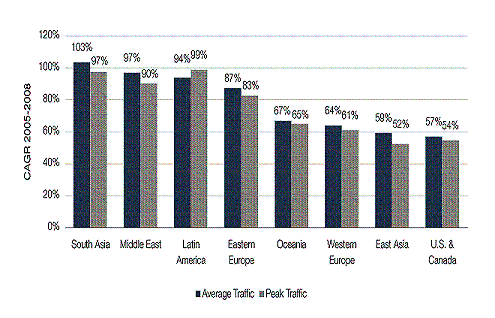 Algeria has recorded a 300% increase in internet advertising during the third quarter of this year, compared to the same period of 2007, reports Algerian daily Le Quotidien d’Oran. This large increase is estimated at 18.6 million Algerian Dinars (US$300,500), compared to only 22 million Algerian Dinars (US$355,500) in an annual spending last year.
Algeria has recorded a 300% increase in internet advertising during the third quarter of this year, compared to the same period of 2007, reports Algerian daily Le Quotidien d’Oran. This large increase is estimated at 18.6 million Algerian Dinars (US$300,500), compared to only 22 million Algerian Dinars (US$355,500) in an annual spending last year.
The Internet has become one of the main media channels used by the 59 identified advertisers across the country who have found it to be a profitable and inexpensive market, that helps them target specific potential customers.
Algeria has not reached the level of other countries in the area of online advertising yet, but it’s on its way as more major advertisers increasingly choose to explore online advertising with small budgets, pending national ADSL deployment and further development of the local content industry.
To better understand this strong increase in online advertising spending in Algeria, Med & Com, the leading online marketing agency in the country, conducted a study on fifty Algerian sites. The results revealed that the holy month of Ramadan saw a peak in online advertising, registering a record of almost 8.5 million Algerian Dinars (US$ 137,365), with 81 campaigns launched by 40 brands.
The report also reveals a strong presence for the automotive, mobile telephony and ICT sectors; The automotive sector through 17 advertisers covered 27% of the online advertising spend, closely followed by ICT and technology services companies with 22%, through 14 advertisers. The communication and web publishing sector accounts for 15% of the total spend, real esate for 8%, as air travel, food and tourism cover 3% each, leaving 14% for other sectors.
Always according to the Med & Com report, press and news portals are increasinly attracting more and more advertisers, taking in 31% of the total online advertising spend. Professional sites get 18%, automotive related sites 17%, Youth and leisure sites another 17%, sport and football sites 11%, and mobile and ICT related sites 7%.
 According to recent market indicators from the National Telecommunications Regulatory Agency (
According to recent market indicators from the National Telecommunications Regulatory Agency (
 Bahrain’s mobile penetration rate has the potential to reach 164 per cent by 2012, a penetration rate, which is already being reached in some European countries and in other parts of the Middle East.
Bahrain’s mobile penetration rate has the potential to reach 164 per cent by 2012, a penetration rate, which is already being reached in some European countries and in other parts of the Middle East. According to official numbers released by the Jordanian Telecommunications Regulatory Commission, the number of internet users in the kingdom reached 1.2 millions users at the end of the first half of 2008, which represents a penetration rate of more than 20.5% of the Jordanian population which currently stands at around 6 million.
According to official numbers released by the Jordanian Telecommunications Regulatory Commission, the number of internet users in the kingdom reached 1.2 millions users at the end of the first half of 2008, which represents a penetration rate of more than 20.5% of the Jordanian population which currently stands at around 6 million. Figures recently released by the Ministry of Communication Technologies reveal a significant growth of mobile phone and internet users in Tunisia. In June 2008 the two mobile phone operators (Tunisie Telecom and Tunisiana) had a combined 8.12 million mobile phone subscribers up from 7 million twelve months earlier.
Figures recently released by the Ministry of Communication Technologies reveal a significant growth of mobile phone and internet users in Tunisia. In June 2008 the two mobile phone operators (Tunisie Telecom and Tunisiana) had a combined 8.12 million mobile phone subscribers up from 7 million twelve months earlier.
